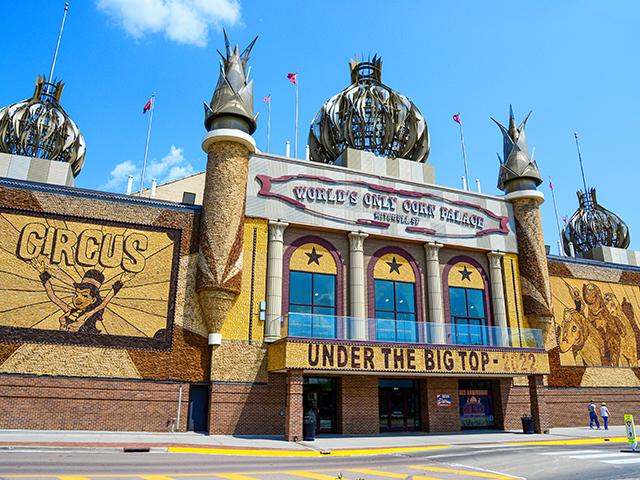This Palace Is More Than a Corny Attraction
Palace on the Prairie
A-maizing, corn-fused, corn-tastrophe -- the name-calling never ends.
Poke all the fun you want at the Corn Palace, in Mitchell, South Dakota, but it has withstood the digs since it was first built in 1892 to attract settlers to the rolling plains of the Dakotas. Today, its claim to fame is that it's the "world's only corn palace," and it's fit for a king.
In May, Cole and Tammy Svenkeson and their two boys, Titan and Daxtin, from Stacey, Minnesota, stopped to visit the Corn Palace after relatives urged them not to miss it.
"I'd never heard of it before," Cole admits, "but the boys read about it, and after seeing it, we all thought it was cool. It might be the start to an annual tradition for us."
Over the years, the downtown Corn Palace has been built and rebuilt three different times to its current version, which was completed in 1921. Throughout its existence, the building has focused on the artistic murals that can be found both inside and outside of the facility.
"It takes as many as 300,000 ears of corn every year to complete the nine outer murals," says Director Doug Greenway, adding that ryegrass and a perennial weed called sour dock also are used. The 17 interior murals are considered permanent.
Besides the intricate murals, the Corn Palace acts as a civic arena for the city, hosting graduations, sporting events, rodeos, banquets and concerts all the way back to the days of composer John Philip Sousa.
P[L1] D[0x0] M[300x250] OOP[F] ADUNIT[] T[]
FROM FIELD TO FINE ART
Local farmer Brett Lowrie, from Mount Vernon, contracts to grow the colored corn for the Corn Palace.
"It all started with Indian corn where kernels were hand-separated into like colors from the multicolored ears. Those kernels were then used to keep color purity," he explains. "Today, I plant 3 to 3.5 acres each of 10 colors. We also buy a green corn and use my yellow field corn. I plant 160-foot-wide strips of soybeans or grain sorghum in between to keep from cross-pollinating."
Though Lowrie employs the same fertility and crop-protection program across all his corn acres, the colored corn is planted at a lower population of 12,000 plants per acre. It's also harvested sooner -- at about 40% moisture -- to keep the ears from breaking when they are cut and nailed to a mural. Ears that are 8 or more inches long work best for the artwork. "I'm more concerned about ear size than I am about yield," Lowrie says, "but in the end, I get anywhere from 60 to 100 bushels per acre."
MURAL MAGIC
Designing murals starts with a theme and a concept, spearheaded by the Corn Palace board. The next step involves working with students studying digital media and design at nearby Dakota Wesleyan University.
"Our students generate designs aligned with the designated theme, and we present this to the board," says professor and department chair Kyle Herges. "After discussions and revisions, we'll get the final endorsement, and the designs are completed. I tell my students that it's a privilege to design artwork that will be viewed by more than 400,000 individuals, plus those on social media."
Jerry Sickbert, from Santa Claus, Indiana, is one of those travelers who says his parents told him stories about it for years. "I was so impressed when I saw it. It almost reminds me of a Rose Bowl float," he says.
COBBLE ON THE CORN
Creating the murals is akin to paint-by-number artwork -- only it's colored corn by the numbers. The students provide a sort of full-sized map that's attached to the building for the decorating crew to follow.
Corn is fastened to the murals, which are backed by treated plywood. All the corn cobs are cut lengthwise so there's a flat side to nail to the plywood. It takes about 200,000 nails, 150,000 staples and 120,000 wire ties to finish the murals.
"Tear-off begins in mid-May, but our goal is to never tear off everything at once so there's always murals for the public to see," says Jeff Hanson, maintenance and decorating supervisor. "In general, we start adding dock in June, ryegrass in July and corn in September. It all has to be finished by December."
By the end of the year, the Corn Palace has gotten its royal treatment once again, and plans begin for the next works of art.
**
-- For more information, visit https://www.cornpalace.com/…
[PF_0923]
(c) Copyright 2023 DTN, LLC. All rights reserved.



